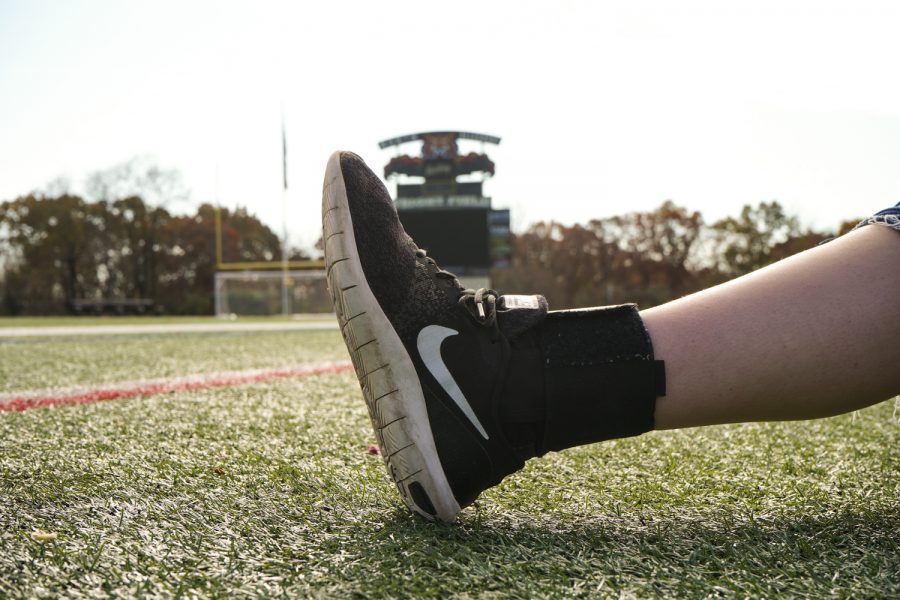A Risky Game to Play
As competition and specialization increase, student-athletes are at greater risk.
An injury that is not properly treated can cause lifelong pain and persistent issues for an athlete.
It’s a scene that’s all too familiar in sports. The star player gets knocked down and injured. They are on the ground. The once loud stadium goes completely silent as a startling sense of fear consumes it. The athlete hobbles off the field.
Miraculously, after half-time or maybe even at the next game, the player returns — pretending as if nothing is wrong, thriving once again.
Behind the scenes, however, the injury lingers. The athlete winces as they tie the limb in a brace or wrap it in compression tape.
This situation speaks to a much larger issue. It’s the current definition of “taking one for the team.” Due to a combination of loyalty and potential pressure, student-athletes continuously push their bodies to the limit, even when it becomes dangerous. In fact, 42% of student athletes have admitted to downplaying or ignoring an injury in order to keep playing.
It’s important to note that North Allegheny has excellent, caring athletic trainers and coaches, and the athletes who struggle with injuries only do so because of their intense commitment to their teammates. There is something incredibly admirable about their sense of camaraderie.
But the long-term impacts of the injuries that athletes fight through can be life-altering. Sprains and tears can cause chronic pain, and too many concussions can leave a player with permanent concentration and memory issues.
The issue lies within the fact that, despite colossal risks, some athletes believe that they must play through the pain in order to be a noble teammate. It’s a mindset adopted in the race for a high school championship, and it is one we must disregard.
It’s hard to think about that bigger picture because sports can become all-consuming. Often, that’s the beauty of it. The tears. The intensity. The passion. It’s why an athlete’s desire to return to the field is so powerful. It’s a risky game, and it’s particularly difficult to do what’s right when emotions take away any hope of objectivity or logic.
Most athletes are guilty of it. At least, I know I am. I started playing lacrosse again two weeks after a high ankle sprain, and because it never healed properly, I sprained it two more times in as many years. Now, it throbs and cramps every time I walk more than a mile, and at sixteen, I feel like an old lady who can tell you when it’s going to rain based on my joint pain.
The sad part is, I got off easy. An ankle injury is meager compared to the repeated concussions, torn ligaments, and stress fractures I’ve seen my teammates sustain.
Even for the lucky few who do not fall victim to major injuries during their high school careers, the overuse of certain muscle groups can be just as treacherous. Sports specialization, or focusing all of one’s training on a single sport year-round, is increasing as high school sports become more competitive.
Research shows that this practice can lead to stress fractures and tendinitis. It can also increase an athlete’s risk of tearing their ACL. The earlier the specialization starts, the more dangerous it is. When growth plates and other soft tissues are still developing, they are much more susceptible to damage.
Dedication, like loyalty, is one of the most valuable lessons that sports can instill in kids and teenagers, but for everyone’s safety, it must be moderated. Typically, experts say that training more than eight months a year for one sport is excessive. So, let’s listen to that. We need to teach youth athletes to recognize when enough is enough and listen to their bodies.
It’s all about perspective, and the truth is, sometimes it’s okay — and even necessary — to be cautious. The stakes are far too high to act otherwise.

Kristen Kinzler is a senior at NASH who loves expressing her opinions and drinking excessive amounts of coffee and tea. When she's not writing or rewatching Supernatural for the fourteenth time, she can probably be found playing lacrosse, reading, or watching hockey. She plans to attend Bowdoin College next fall.


